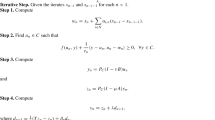Abstract
A modified mixed/hybrid finite element method, which is no longer reguired to satisfy the Babuska-Brezzi condition, is referred to as a stabilized method. Based on the duality of variational principles in solid mechanics, a new type of stabilized method, called the combinatorially stabilized mixed/hybrid finite element method, is presented by weight-averaging both the primal and the dual “saddle-point” schemes. Through a general analysis of stability and convergence under an abstract framework, it is shown that for the methods only an inf-sup inequality much weaker than Babuska-Brezzi condition needs to be satisfied. As a concrete application, it is concluded that the combinatorially stabilized Raviart and Thomas mixed methods permit theC (0)-elements to replace theH(div; Ω)-elements.
Similar content being viewed by others
References
Brezzi, F., Douglas, J., Stabilized mixed methods for Stokes problem,Numer. Math., 1988, 53: 225.
France, L. P., Hughes, T. J. R., Two classes of mixed finite element methods,Comput. Meth. Appl. Mech. Engrg., 1988, 69: 89.
Hughes, T. J. R., Franca, L. P., Balestra, M., A new finite element formulation of computational fluid dynamics, a stable Petrov-Galerkin formulation of the Stokes problem accommodating equal-order interpolations,Comp. Meth. Appl. Mech. Eng., 1986, 59: 85.
Zhou, T.-X., Feng, M.-F., A least squares Petrov-Galerkin finite element method for the stationary Navier-Stokes equations,Math. Comp., 1993, 60(202): 531.
Fix, G. J., Gunzburger, M. D., Nicolaides, R. A., On mixed finite element methods for the first elliptic systems,Numer. Math., 1981, 37: 29.
Neittanmaki, P., Picard, R., On finite element approximation of the gradiant for the solution of Poisson equation,Numer. Math., 1980, 37: 333.
Pehlivanov, A. I., Carey, G. F., Error estimates for least-squares finite elements,M 2 AN, 1994, 28: 499.
Brezzi, F., On the existence, uniqueness and approximation of saddle point arising from Lagrange multipliers,RAIRO Anal. Numer., 1974, R-2: 129.
Brezzi, F., Fortin, M.,Mixed/Hybrid Finite Element Method, New York: Springer-Verlag, 1991.
Zhou, T.-X., Stabilized finite element methods for a model parameter-dependent problem, inProceedings of the Second Conference on Numer. Meth. for Part. Differ. Equation (eds. Ying, L., Guo, B.), Singapore: World Scientific, 1991, 148–156.
Zhou, T. X., A partial projection method of finite element discretizations for the Reissner-Mindlin plate model,J. Comput. Math., 1995, 13(2): 172.
Raviart, P. A., Thomas, J. N., A mixed finite element method for second order elliptic problems, Mathematical aspects of the finite element method (eds. Galligani, I., Magenics, E.),Lecture Notes in Math, 606, New York: Springer-Verlag, 1977.
Raviart, P. A., Thomas, J. M., Primal hybrid finite element methods for second order elliptic equations,Math. Comp., 1977, 37: 391.
Zhou, T.-X., Equivalence theorem for saddle point finite element schemes and two criteria of strong Babuska condition,Scientia Sinica, 1981, 24: 1190.
Author information
Authors and Affiliations
Rights and permissions
About this article
Cite this article
Zhou, T. Finite element method based on combination of “saddle point” variational formulations. Sci. China Ser. E-Technol. Sci. 40, 285–300 (1997). https://doi.org/10.1007/BF02916604
Received:
Issue Date:
DOI: https://doi.org/10.1007/BF02916604




